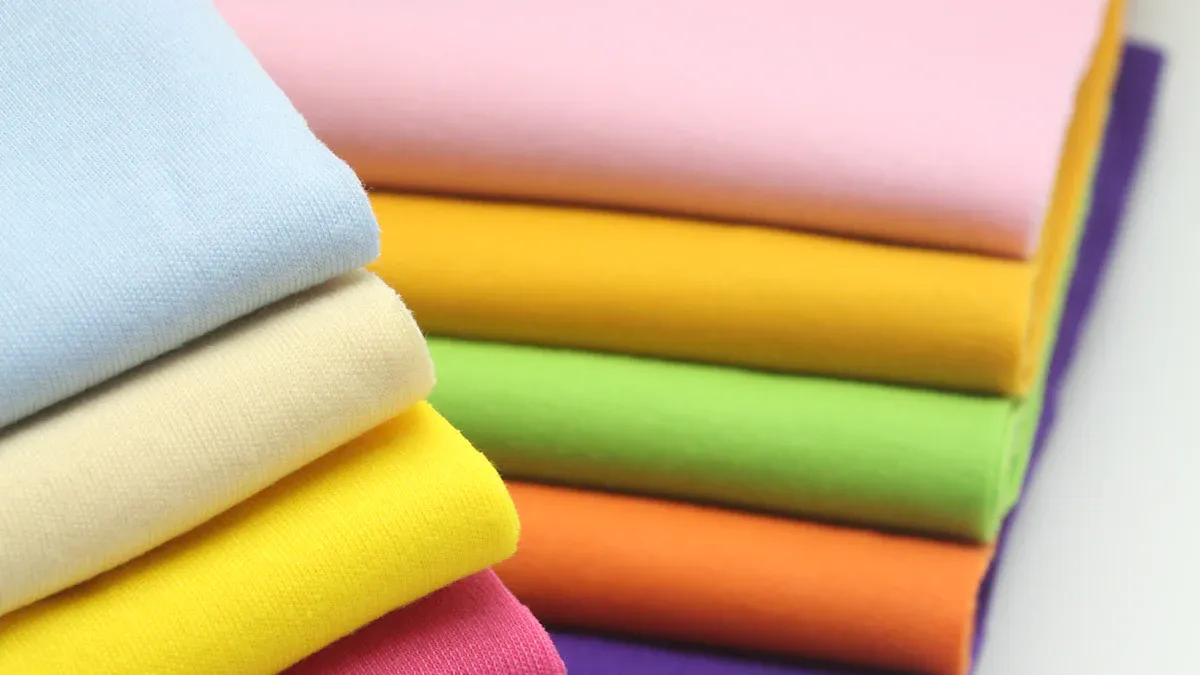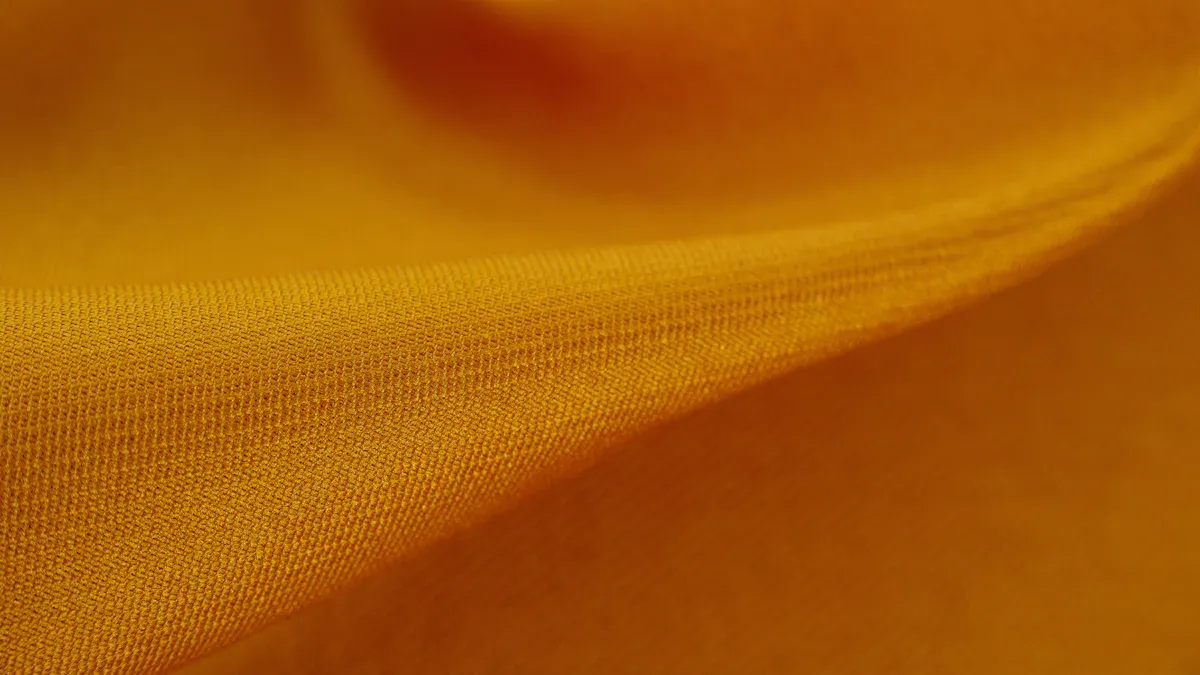
When you ask what polyester fabric is, you discover it is a synthetic fabric made from petroleum-based fibers. Polyester stands out for its strength, easy care, and versatility. You will notice that this fabric feels smooth and soft, making it comfortable for everyday wear.
With its ability to resist wrinkles and maintain shape, polyester fabric has become a favorite for clothing and home textiles. According to Textile Exchange’s 2023 report, polyester fabric made up 54% of global fiber production in 2022, showing its unmatched versatility and popularity.
When you explore what is polyester fabric, you see how its versatility and durability support many uses, from fashion to bedding.
Key Takeaways
Polyester fabric is a strong, durable synthetic material made from petroleum-based fibers that resists wrinkles and holds its shape well.
This fabric feels smooth and soft, offers easy care, dries quickly, and is breathable, making it comfortable for everyday wear and sleepwear.
Polyester is versatile and used in many products like clothing, pajamas, home textiles, and industrial goods due to its strength and cost-effectiveness.
Proper care, such as washing in cool water and avoiding high heat drying, helps polyester fabric stay fresh and last longer.
Choosing high-quality polyester, like Friendtex products, ensures safety, comfort, and durability while supporting eco-friendly practices.
What is Polyester Fabric?

Polyester Fabric Definition
When you explore what polyester fabric is, you find that it is a synthetic material made from long-chain polymers. The most common type is called polyethylene terephthalate, or PET. This fabric comes from a chemical process that starts with petroleum.
Manufacturers refine petroleum to create ethylene and p-xylene. These chemicals react to form PET, which is then melted and spun into fibers. You see these polyester fibers twisted into yarn and woven or knitted into fabric.
Polyester fabric stands out because it is engineered for strength, durability, and easy care.
Here is a simple breakdown of how polyester fabric is made:
Petroleum is refined to extract ethylene and p-xylene.
These chemicals react to form PET polymer.
PET is melted and spun into fibers.
Fibers are twisted into yarn and made into fabric.
Finishing steps like dyeing and heat setting improve the fabric’s look and feel.
Polyester fabric often goes through extra finishing steps. These steps help the fabric resist wrinkles, keep its color, and manage moisture. You will notice that polyester fabric can be made in different ways to suit many uses, from clothing to bedding.
What Kind of Fabric is Polyester?
You might wonder where polyester fits among other fabrics. Polyester belongs to the synthetic fiber category. This means it is made by humans, not from plants or animals. Other synthetic fibers include nylon, acrylic, and spandex.
Polyester fabric is different from natural fabrics like cotton or wool. It does not absorb water easily, so it dries quickly and resists stains.
Polyester fabric is often blended with natural fibers. For example, you may find polyester-cotton blends in shirts or sheets. These blends combine the best features of both fibers. Polyester adds strength and wrinkle resistance, while cotton adds softness and breathability.
Here is a quick comparison table:
Fabric Type | Source | Key Features |
|---|---|---|
Polyester | Synthetic | Durable, wrinkle-resistant |
Cotton | Natural | Soft, breathable |
Nylon | Synthetic | Strong, stretchy |
Wool | Natural | Warm, moisture-wicking |
You see, polyester fabricis used in many products because it is versatile and cost-effective.
What Does Polyester Fabric Feel Like?
When you touch polyester fabric, you notice a smooth and soft texture. The surface feels gentle against your skin. Polyester fabric can feel lightweight or slightly silky, depending on how it is woven or finished. Many people enjoy the comfort of polyester pajamas because the fabric feels cozy and does not cling.
Polyester fabric does not wrinkle easily. You can pack it in a bag, and it will still look neat when you take it out. The fabric holds its shape well, even after many washes. Some polyester fabrics feel cool and breathable, especially when blended with cotton or spandex. Others may feel a bit warmer, which makes them great for cooler nights.
Tip: If you want pajamas that stay soft and fresh, look for high-quality polyester fabric like the one used by Friendtex. These fabrics offer comfort, durability, and easy care for everyday use.
How is Polyester Fabric Made?
Polyester Raw Materials
You find that polyester starts with synthetic polymers made from petrochemicals. The main raw materials include ethylene and terephthalic acid, both derived from crude oil. These chemicals form the base for polyester fibers. The global supply chain for polyester is complex and stretches across many countries.
Most polyester comes from China, while cotton and wool, sometimes blended with polyester, come from the United States and India. Production often takes place in countries like Bangladesh, Vietnam, and Turkey, where labor costs are lower.
Here is a quick look at the supply chain:
Aspect | Details |
|---|---|
Raw Materials | Polyester fibers (synthetic polymers from petrochemicals), cotton, wool |
Polyester Source | Mainly China |
Cotton Source | United States, India |
Production Locations | Bangladesh, Vietnam, Turkey |
Supply Chain Stages | Sourcing, production, distribution, retail |
Supply Chain Nature | Global, interconnected, sensitive to disruptions |
Polyester fabric stands out because its chemical composition gives it strength and durability. Friendtex uses only high-quality, certified polyester in its products, ensuring safety and comfort.
Types of Polyester Fabric
You will notice several types of polyester fabric in the market. The most common is PET (polyethylene terephthalate), which you find in clothing and home textiles. Other types of polyester fabric include PCDT (poly-1,4-cyclohexylene-dimethylene terephthalate), which offers more elasticity and is used in heavy-duty applications.
Blends, such as polyester-cotton or polyester-spandex, combine the best features of each fiber. The composition of these blends affects softness, stretch, and breathability.
When you choose polyester products from Friendtex, you benefit from a wide range of fabric types, each designed for specific uses like pajamas, sportswear, or bedding.
Manufacturing Process
The process of making polyester involves several steps:
You start with crude oil extraction.
Refineries turn crude oil into petrochemicals like ethylene and terephthalic acid.
These chemicals combine to form PET, the main polymer in polyester.
Factories polymerize PET by reacting dimethyl terephthalate with ethylene glycol at high temperatures.
The resulting polymer is melted and extruded through spinnerets to create continuous polyester fibers.
Heat stretching draws the fibers, increasing their strength.
The fibers are wound onto bobbins, then woven or knitted into fabric.
Finishing treatments, such as anti-static or water-repellent coatings, improve performance.
Friendtex ensures every batch of polyester meets strict quality standards. The company uses internal tests and third-party audits to comply with certifications like OEKO-TEX® Standard 100 and GOTS. This commitment guarantees that you receive safe, high-quality polyester products.
Polyester Fabric Characteristics
Durability and Strength
You will notice that polyester fabric stands out for its impressive durability. This fabric resists stretching, shrinking, and tearing, even after many washes. Polyester holds its shape well, so your clothes look new for longer.
When you choose polyester, you get a fabric that can handle daily wear and frequent washing. Friendtex Polyester Pajamas use high-quality polyester, which means you enjoy long-lasting comfort and value. Many people prefer polyester for uniforms, sportswear, and sleepwear because of its strength.
Breathability and Comfort
You might wonder if polyester fabric feels comfortable. Modern technology allows manufacturers to create breathable polyester that feels soft and light. This fabric lets air flow, so you stay cool and dry. Friendtex designs pajamas with breathable polyester to give you a cozy and fresh feeling all night.
The smooth texture of this fabric feels gentle on your skin. You can wear polyester pajamas in different seasons because of their versatility.
Tip: Choose pajamas made from breathable polyester for a comfortable sleep, especially if you want a fabric that dries quickly and resists wrinkles.
Stretch and Flexibility
Polyester fabric offers excellent flexibility. You can move freely because this fabric stretches and returns to its original shape. Many polyester blends, such as polyester-spandex, increase stretch and comfort.
Friendtex uses these blends in pajamas to give you ease of movement. You will find that polyester adapts to your body, making it a popular choice for activewear and loungewear.
Appearance and Texture
Polyester fabric has a smooth, soft surface that looks polished. This fabric resists wrinkles, so you spend less time on care and ironing. Colors stay bright and vibrant, even after many washes.
Friendtex Polyester Pajamas keep their fresh look because of the high-quality polyester used. The versatility of polyester means you can find it in shiny, matte, or textured finishes. You get a fabric that looks good and feels pleasant.
Note: The properties of polyester fabric make it easy to care for and maintain, which adds to its popularity in modern wardrobes.
What is Polyester Fabric Used For?

Clothing and Fashion
You see polyester fabric everywhere in the world of apparel. This fabric has become a staple in modern clothing because of its durability and easy care. When you look at your wardrobe, you likely find many items made from polyester.
The most popular types of polyester clothing include shirts, pants, hoodies, dresses, jackets, underwear, socks, children’s clothing, jeans, maternity activewear, sports clothing, swimwear, and T-shirts. Polyester fabric helps these garments keep their shape and color, even after many washes.
You benefit from wrinkle resistance and quick drying, which makes polyester ideal for busy lifestyles. The versatility of polyester allows designers to create both casual and performance apparel that suits every season.
Friendtex Polyester Pajamas
If you want comfort and style in your sleepwear, you should consider Friendtex polyester pajamas. Friendtex specializes in premium polyester pajamas that combine softness, breathability, and lightweight comfort. You can choose from a wide range of styles, including pants, shorts, sets, and tops.
Friendtex offers customization options, so you can select colors, patterns, and even add your brand’s logo. These pajamas use high-quality polyester fabric that resists wrinkles and maintains its softness after many washes.
You enjoy pajamas that look fresh and feel cozy every night. Friendtex’s expertise in apparel manufacturing ensures you receive products that meet high standards for quality and design.
Tip: Friendtex polyester pajamas are perfect for brands and retailers who want to offer unique, comfortable, and durable sleepwear.
Home and Industrial Uses
Polyester fabric extends far beyond clothing. You find it in many homewares and industrial products because of its strength and stain resistance. In your home, polyester appears in blankets, sheets, upholstery, bath towels, face towels, kitchen towels, rugs, curtains, and cushioning for chairs, sofas, and pillows.
These homewares benefit from polyester’s ability to wick moisture and resist wear. In industry, polyester supports products like LCD displays, holographic film, boats, tarps, and bottles.
The versatility of polyester fabric makes it a top choice for both home and industrial uses. When you ask how is polyester fabric used, you see its impact in every part of daily life.
Polyester Care and Impact
Washing and Maintenance
You can keep polyester fabric looking new with simple care. Always check the care instructions for polyester before washing. Textile experts recommend these steps for best results:
Wash polyester in cool water with a mild detergent.
Use a stain remover if needed.
Air-dry by laying flat or hanging to avoid wrinkles.
Tumble dry on low or medium heat if you prefer.
Hang items promptly after drying to prevent odors.
Polyester fabric is low-maintenance and durable. Washing with hot water or too often can cause fiber shedding and reduce quality. Choose cold water and wash less frequently to preserve the fabric. Avoid high heat during drying to maintain the garment’s appearance. Friendtex Polyester Pajamas stay soft and fresh when you follow these care tips.
Environmental Impact
Polyester production has a significant effect on the environment. Making polyester fabric generates two to three times more carbon emissions than cotton. In 2022, factories used about 70 million barrels of oil for polyester. The fashion industry, including polyester textiles, creates around 10% of global carbon emissions.
Textile manufacturing also uses large amounts of water. Wet processing, such as dyeing and finishing, accounts for most water use. Dyeing polyester fabric can release heavy metals and toxins, which pollute clean water. Friendtex supports sustainability by using certified polyester and eco-friendly practices.
Health and Safety
You can wear polyester fabric safely when it meets quality standards. High-quality polyester, like that used by Friendtex, is free from harmful chemicals. Always follow care instructions for polyester to avoid skin irritation. Polyester fabric resists mold and mildew, making it a good choice for sleepwear and apparel.
Polyester vs Other Fabrics
You may wonder how polyester compares to other fabrics. Here is a quick guide:
Polyester fabric vs cotton
Polyester fabric dries faster and resists wrinkles. Cotton feels softer and absorbs moisture better. Polyester lasts longer and needs less care.
Nylon fabric vs polyester
Nylon is stronger and more elastic. Polyester fabric resists stains and sunlight better.
Rayon vs polyester fabric
Rayon feels softer and breathes more. Polyester fabric is more durable and easier to care for.
Modal fabric vs polyester
Modal is softer and more absorbent. Polyester fabric keeps its shape and color longer.
Viscose fabric vs polyester
Viscose feels silky and drapes well. Polyester fabric is stronger and dries faster.
Chenille fabric vs polyester
Chenille is plush and textured. Polyester fabric is smoother and easier to maintain.
Lyocell fabric vs polyester
Lyocell is eco-friendly and soft. Polyester fabric is more affordable and durable.
milk silk fabric vs polyester
Milk silk is soft and gentle on skin. Polyester fabric offers better durability and care.
Tip: Friendtex offers a range of polyester fabric blends, so you can choose the best option for your clothing needs.
Conclusion
You have seen how polyester shapes the modern textile industry. Polyester stands out for its durability, versatility, and cost-effectiveness. You find polyester fabric in clothing, home goods, and industrial products. Friendtex Polyester Pajamas show how innovation and quality come together in sleepwear.
Advances in technology now make polyester more breathable and sustainable. If you want to learn more about eco-friendly polyester, many guides explain recycled polyester, its benefits, and how it helps reduce waste. Choose polyester products that fit your needs and values.
FAQ
What makes polyester fabric easy to care for?
Polyester resists wrinkles and dries quickly. You can wash it in cold water and tumble dry on low. The fabric keeps its shape and color after many washes. You spend less time ironing and more time enjoying your clothes.
Are polyester pajamas comfortable for all seasons?
Yes, you can wear polyester pajamas year-round. The fabric feels lightweight and breathable. Friendtex uses high-quality polyester that helps you stay cool in summer and cozy in winter.
Can you customize polyester pajamas with your brand logo?
Absolutely! Friendtex offers customization options for polyester pajamas. You can choose colors, patterns, and add your brand’s logo. This helps your products stand out in the market.
Is polyester fabric safe for sensitive skin?
High-quality polyester, like the kind Friendtex uses, is safe for most skin types. The fabric feels soft and smooth. Always check for certifications to ensure safety and comfort.
How does polyester compare to cotton in terms of durability?
Polyester lasts longer than cotton. The fibers resist stretching, shrinking, and fading. You get more wear from polyester garments, making them a smart choice for everyday use.


